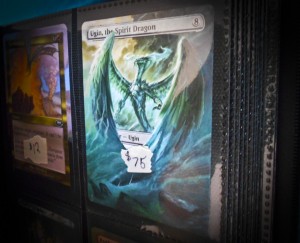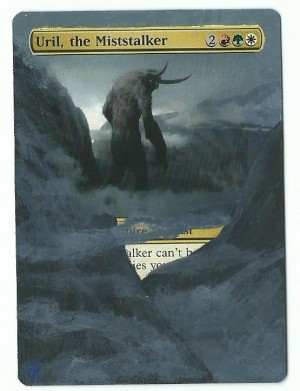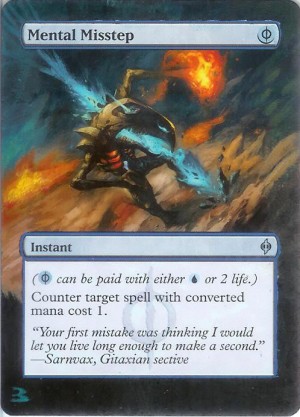Are you a Quiet Speculation member?
If not, now is a perfect time to join up! Our powerful tools, breaking-news analysis, and exclusive Discord channel will make sure you stay up to date and ahead of the curve.
Now that you have an altered card (or two) we can discuss how to move it. There are really only two options here: trading and selling. As you may have guessed from the title today I am going to discuss trading altered cards.
Pricing Your Work
Before you go anywhere or trade with anyone, it is important that you know how to price your work. I use a simple formula to price my cards. I take the price of the card and add it to my labor cost (hourly rate multiplied by hours worked) to find my final value. I always round up to the nearest dollar.
Card + (HR*HW) = Price
In the case of our altered [cards]Plains[/card] the card is worth $1.50. It took me roughly an hour to finish and I pay myself $10 an hour. Therefore this card is worth $12 after you round up from $11.50. I also try to make sure that my price is less than that of the foil version of the card. Of course there are exceptions to this rule, but it is a good guideline to keep in mind. With the cost of certain foils many people will look to altered cards to get a unique version of a card at a discount. Reminding people of this possibility helps when negotiating.

On the flip side, you hurt yourself and the altering community as a whole if you undervalue your work. Yes, you will likely get your sale but you will also be short-changing yourself on profits. This will force you to either cut corners on your work to make it worth your time or create a situation where painting is simply not worth it. If you take pride in your work, then show it in your prices.*
I have one final note about prices. They should be clearly visible within your trade binder. I use small pieces of masking tape and a pen to write my prices on the pages of my binder.
People almost always know how much Ugin, the Spirit Dragon is worth, but they may not know how much you are asking for your altered version. Marking your prices will eliminate the obvious question. It lets your buyer know that you are not just making prices up on the spot. In this way pricing your work helps to give your buyer a sense of security as well as a starting point for negotiations.
Finding Your Buyer
The number of people interested in altered cards is growing rapidly, but it is still just a fragment of the player base. In my experience, seven out of ten Magic players are interested in altered cards and three out of ten are motivated to buy. Even though these numbers will vary given your local player base, for the sake of this article let's assume that they're true across the board.
In order to reach these three motivated buyers we have to advertise to all ten. In our case advertising does not necessarily mean purchasing ad space on the wall of your local game store.

I keep my alters in the very front pages of my trade binder to ensure that everybody who opens it gets a look at them. I also make sure that I show my binder to everybody that I possibly can.
This is where the seven people who are interested (but not necessarily willing to buy) come in. They do all of the advertising for you by asking questions like "Did you do this artwork?" and saying things like "These are so cool!". It is word of mouth in a literal sense. Anybody who is interested in buying now knows where to go.
When you do come to these inevitable comments, you should always make sure to remind them that you do commission work. As an additional follow up, I like to remind people that EDH generals look amazing when altered.
This instantly gets your trade partner's mind working on who or what they would like altered, regardless of whether they intended to do so before opening your binder. If you get one commission job at FNM then you have paid for your draft.
Trading to Your Buyer
Once you have found your trading partner then you should proceed as normal through the trading process. It is important to know the prices that you have set beforehand and remain firm on them. If you value your altered Plains from $12 to $15 (as you should) then treat it as though it were a Polluted Delta.
Feel free to be a little flexible, but never let anyone talk you into reducing the price of your work. There are always more buyers for your card. Don't be afraid to walk away.

*Pro Tip: ALWAYS take pride in your work!






very valuable lessons, very interresting insight. I like to read something new.
Still had no time to start on alters.
I’m enjoying this series, a great deal…but one word of caution…if you go to a big event and have prices written in your binder, you may run into issues with the TO. Some TO’s are very explicit about not having pricing on anything if you aren’t an official vendor….some LGS’s might also take offense to you selling cards in their store (so make sure you run things by your LGS owner first).
Thats a good point and I’ll be sure to mention it in my next article. Thank you very much!
So I’m guessing from this article that you sell and trade out your alters at the same price?
For the most part yes. There are some instances on higher dollar cards where I will charge more on trades the way that one might ask a small premium for trading Legacy cards for Standard. While cash is great, I view trading for cards to be an injection straight into my painting inventory. So I don’t suffer as much from having to liquidate what I traded for.